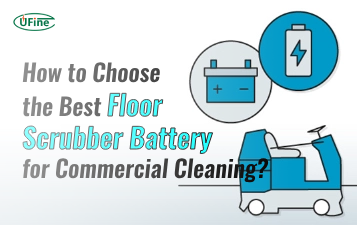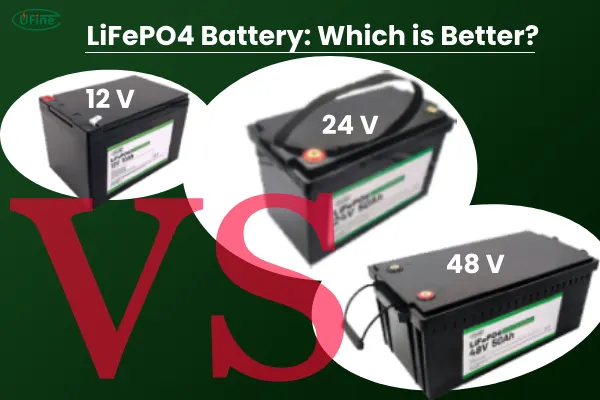The selection of LiFePO4 batteries (Lithium Iron Phosphate) is critical for applications ranging from renewable energy systems to electric vehicles. The voltage choice — 12V, 24V, or 48V — significantly impacts system performance, efficiency, scalability, and overall cost. Each voltage configuration brings unique advantages and challenges, and understanding these differences is crucial when determining the best solution for your specific needs.
As a trusted custom lithium battery manufacturer with over 17 years of experience, Ufine Battery specializes in producing tailor-made LiFePO4 batteries that are designed to meet the precise voltage, capacity, and application requirements of our clients. Let’s explore the key factors that influence the choice of 12V, 24V, and 48V LiFePO4 batteries, diving into technical specifications, real-world applications, and long-term performance considerations.
Part 1. Energy efficiency and voltage loss
The efficiency of a battery system is greatly influenced by voltage levels, especially in applications requiring long-distance power transmission, such as solar systems or electric vehicles.
When it comes to 12V systems, energy efficiency can be compromised over longer cable runs due to higher voltage drop and resistive losses. Power losses increase as the current increases, which is common when transmitting energy over greater distances or to high-load devices. As a result, larger gauge wires are needed to compensate for this loss, driving up costs and potentially reducing the system’s efficiency.
24V systems are more efficient than 12V systems in power transmission, especially over moderate distances. By doubling the voltage, the system can reduce the current, which in turn lowers the resistive losses in wires. Therefore, 24V batteries are suitable for medium-power applications where moderate distances need to be covered, such as powering RVs or small solar installations. Although 24V is more efficient than 12V, it still has room for improvement compared to 48V systems.
The 48V LiFePO4 battery is the most efficient configuration for long-distance power transmission, particularly when dealing with large loads or commercial-scale applications. As voltage increases, the current required for the same power output decreases, which translates into lower transmission losses. This efficiency is critical in high-demand systems such as industrial machinery, large solar farms, or high-powered electric vehicles (EVs).
Winner: 48V. The higher the voltage, the lower the energy loss over distances, making 48V the most energy-efficient choice for large-scale or high-demand applications.
Part 2. Current capacity and power output
Power output is a crucial factor when choosing the right battery for any system. The relationship between voltage and current plays a fundamental role in determining the battery’s capacity and power output.
12V LiFePO4 Battery:
12V batteries are well-suited for smaller devices or systems with low power requirements. They are typically used in applications such as small solar setups, emergency backup systems, and low-power vehicles like scooters. The capacity of a 12V battery is adequate for small-scale operations, but the need to wire multiple batteries in series to increase the voltage limits the scalability for larger setups.
24V LiFePO4 Battery:
24V systems provide a more balanced combination of voltage and current, offering higher power output than 12V batteries while maintaining manageable size and weight. A 24V battery can support applications like RV systems, solar inverters, and electric wheelchairs. The capacity of a 24V LiFePO4 battery enables it to handle medium-load devices without sacrificing performance, making it a versatile choice for mid-range power applications.
48V LiFePO4 Battery:
48V LiFePO4 batteries deliver the highest power output among the three. They are typically used in high-power applications where a significant amount of energy is required over long periods of time. These batteries are ideal for electric vehicles, large solar power systems, and industrial machinery. Because of the higher voltage, 48V systems provide better power stability, handling more demanding applications with ease.
Winner: 48V. If you require higher power output for large-scale applications, 48V systems are the most effective.
Part 3. Charging time and convenience
Charging time is often an overlooked but critical consideration when evaluating different battery systems. The longer the charging time, the longer it will take for a system to be ready for use again. Faster charging ensures higher operational availability.
12V LiFePO4 Battery:
Due to their lower voltage and smaller capacity, 12V LiFePO4 batteries charge faster than their higher-voltage counterparts. This makes them ideal for small systems where quick turnaround is important, such as backup power for household appliances, solar-powered lights, or small electric vehicles.
24V LiFePO4 Battery:
24V batteries will take longer to charge compared to 12V systems but can still be relatively quick, especially when high-quality chargers are used. Charging times are generally acceptable for most medium-duty applications, like RV systems or small solar arrays.
48V LiFePO4 Battery:
48V batteries will require the longest charging times due to their higher capacity and voltage. However, fast-charging technologies can mitigate this issue. In applications where constant uptime is essential, such as large-scale solar systems or EVs, the relatively longer charging times of 48V systems may not be as critical.
Winner: 12V. For users needing fast recharge times, 12V LiFePO4 batteries are the best option.
Part 4. Scalability and System Expansion
The ability to scale a system up is another key consideration when choosing a voltage configuration. Over time, you may need to expand your energy capacity, so system scalability becomes crucial.
12V LiFePO4 Battery:
12V systems can be scaled relatively easily by wiring multiple batteries in series and parallel. This provides flexibility for applications like solar panel installations or backup systems, where you can gradually expand the system’s power capacity as needed. However, while they are flexible, the need for additional wiring increases complexity as you scale up.
24V LiFePO4 Battery:
24V systems are also scalable, but the expansion is typically more efficient and less complex than 12V systems, particularly when multiple 24V batteries are connected in parallel. Since 24V systems provide more power per unit than 12V, you can achieve a higher overall capacity with fewer batteries.
48V LiFePO4 Battery:
48V systems have limited scalability compared to 12V and 24V options. They are typically used in large-scale applications where expansion is not frequent. However, in industrial or commercial environments, the 48V system is preferred for its power handling and long-term reliability, as fewer connections and batteries are required to achieve a large system capacity.
Winner: 12V. For scalability and flexibility in smaller applications, 12V systems are easier to expand over time.
Part 5. Cost-effectiveness and financial considerations
Cost is always a major factor when deciding between different battery options. The initial investment and the long-term costs need to be evaluated.
12V LiFePO4 Battery:
12V systems are the most cost-effective solution for smaller power needs. Their low cost makes them ideal for applications with budget constraints, such as small solar power setups or backup systems. Although you may need more batteries for larger power needs, the lower initial cost remains an advantage.
24V LiFePO4 Battery:
The cost of a 24V LiFePO4 battery is higher than 12V batteries but generally more affordable than 48V systems. 24V offers the best cost-to-performance ratio for mid-range power applications. It’s suitable for medium-scale applications, like RVs or smaller solar power installations, where you need a balance of cost and power.
48V LiFePO4 Battery:
48V systems are the most expensive to purchase upfront due to the higher capacity and advanced technology required. However, for high-power systems, they can save money in the long term due to the reduced wiring, improved energy efficiency, and higher reliability for large applications.
Winner: 24V. For applications requiring balanced performance and cost-efficiency, 24V LiFePO4 batteries are ideal.
Part 6. Longevity and battery life cycle
The lifespan of a LiFePO4 battery is a crucial consideration for long-term performance. Factors such as cycle life, depth of discharge (DoD), and charging cycles play a key role in determining battery longevity.
12V LiFePO4 Battery:
12V LiFePO4 batteries have a relatively long lifespan compared to other chemistries, typically ranging from 2,000 to 5,000 cycles depending on usage and maintenance. However, the cycle life can be shortened if the battery is consistently discharged deeply or charged improperly.
24V LiFePO4 Battery:
24V systems have similar cycle life to 12V systems, ranging between 2,500 and 4,500 cycles. Higher voltage systems generally offer better performance at deeper discharges, which can improve overall lifespan with proper maintenance.
48V LiFePO4 Battery:
48V LiFePO4 batteries also boast impressive cycle life, with most systems lasting between 3,000 to 7,000 cycles. The higher voltage and larger capacity often result in better long-term performance as these systems are designed for heavy-duty applications.
Winner: 48V. For the best longevity and life cycle, 48V LiFePO4 batteries perform well under high-demand applications.
Part 7. Which battery voltage is best for you?
Selecting the optimal LiFePO4 battery voltage depends on your specific needs, budget, and application requirements:
- 12V LiFePO4: Best for small-scale, cost-sensitive, and portable applications like RVs, boats, and backup power.
- 24V LiFePO4: Ideal for mid-range applications where efficiency, balance between cost and power, and moderate scalability are required (e.g., RV systems, small solar arrays).
- 48V LiFePO4: Best suited for high-power, commercial, and large-scale systems, where efficiency, energy output, and long-term performance are critical.
For any customized needs, whether you need a 12V, 24V, or 48V LiFePO4 battery, Ufine Battery can provide the ideal solution tailored to your specifications, ensuring both high performance and reliability.
Related Tags:
More Articles

How to Choose the Best Floor Scrubber Battery for Commercial Cleaning?
Selecting the ideal floor scrubber battery ensures a long runtime, rapid charging, and minimal maintenance for efficient commercial cleaning operations.
Battery for Blower vs Battery for Leaf Vacuum: Which One Should You Choose?
Battery for blower vs leaf vacuum—learn the key differences in power, fit, and runtime to choose the right battery for your outdoor tool needs.
How to Choose the Right Battery for Blower?
Choosing the right blower battery? Consider voltage, capacity, chemistry & usage. This guide helps match the best battery for peak performance.
How to Choose the Best Insulated Battery Box for Lithium Batteries?
Choosing the Best Insulated Battery Box for Lithium Batteries? Discover key factors such as size, material, and safety for optimal protection and performance.
7 Critical Elements on a Lithium Battery Shipping Label
What must be on a lithium battery shipping label? Learn 7 key elements to ensure safety, legal compliance, and correct handling across all transport modes.




